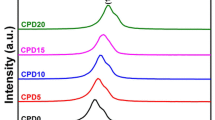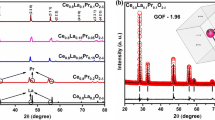Abstract
Ni cermets have been widely investigated as anode materials for solid oxide fuel cells (SOFCs), particularly for those based on O2−-conducting electrolytes, e.g., yttria-stabilized zirconia (YSZ). However, proton ceramic fuel cells (PCFCs) are increasingly attracting research attention, considered to be another developmental step in high-temperature fuel cell technologies. Ni cermets with a ceramic matrix capable of performing proton transfer are believed to be prospective anode materials for PCFCs. This work is aimed at investigating materials that can be used as supporting anodes with LaScO3-based proton-conducting electrolytes. La0.95Sr0.05ScO3−δ (LSS5) as a potential ceramic component was synthesized by solid-phase and co-precipitation methods. Ni-LSS5 composites were obtained by solid-state mixing of the respective powders followed by reduction in hydrogen. Effects of the LSS5 powder production technique and sintering temperature (1400, 1450, and 1500 °С) on the microstructural features and phase composition were studied using both oxidized and reduced samples. The temperature dependencies of resistivity, as well as of thermal and chemical expansions, were investigated in situ. It is found that the electrical conductivity and chemical expansion of Ni-LSS is largely determined by its porosity rather than by the selected synthesis method. The materials under study are shown to exhibit relatively small values of chemical expansion and resistivity, making them promising for application in anode-supported PCFCs with LaScO3-based proton-conducting electrolytes.

.









Similar content being viewed by others
References
Shao Z, Tadé MO (2016) Intermediate-temperature solid oxide fuel cells: materials and applications. Springer, Berlin
Jiang SP, Chan SH (2004) A review of anode materials development in solid oxide fuel cells. J Mater Sci 39(14):4405–4409
Malavasi L, Fisher CAJ, Islam MS (2010) Oxide-ion and proton conducting electrolyte materials for clean energy applications: structural and mechanistic features. Chem Soc Rev 39(11):4370–4087
Iwahara H, Asakura Y, Katahira K, Tanaka M (2004) Prospect of hydrogen technology using proton-conducting ceramics. Solid State Ionics 168(3-4):299–310
Fabbri E, Bi L, Pergolesi D, Traversa E (2012) Towards the next generation of solid oxide fuel cells operating below 600 °C with chemically stable proton-conducting electrolytes. Adv Mater 24(2):195–208
Kreuer KD (2003) Proton-conducting oxides. Annu Rev Mater Res 33(1):333–359
Norby T (2007) Ceramic proton and mixed proton-electron conductors in membranes for energy conversion applications. J Chem Eng Jpn 40(13):1166–1171
Kuzmin АV, Stroeva AY, Gorelov VP, Novikova YV, Lesnichyova AS, Farlenkov AS, Khodimchuk АV (2019) Synthesis and characterization of dense proton-conducting La1-xSrxScO3-α ceramics. Int J Hydrog Energy 44(2):1130–1138
Gorelov VP, Stroeva AY (2012) Solid proton conducting electrolytes based on LaScO3. Russ J Electrochem 48(10):949–960
Farlenkov AS, Smolnikov AG, Ananyev MV, Khodimchuk AV, Buzlukov AL, Kuzmin AV, Porotnikova NM (2017) Local disorder and water uptake in La1–xSrxScO3–δ. Solid State Ionics 306:82–88
Stroeva AY, Gorelov VP, Kuz’Min AV, Antonova EP, Plaksin SV (2012) Phase composition and conductivity of La1–xSrxScO3-α (x = 0.01-0.20) under oxidative conditions. Russ J Electrochem 48(5):509–517
Kuzmin AV, Stroeva AY, Plekhanov MS, Gorelov VP, Farlenkov AS (2018) Chemical solution deposition and characterization of the La1-хSrxScO3-a thin films on La1-xSrxMnO3-a substrate. Int J Hydrog Energy 43(41):19206–19212
Yugami H, Kato H, Iguchi F (2014) Protonic SOFCs using perovskite-type conductors. Adv Sci Tech 95:66–71
Antonova EP, Kolchugin AA, Pikalova EY, Medvedev DA, Bogdanovich NM (2017) Development of electrochemically active electrodes for BaCe0.89Gd0.1Cu0.01O3-δ proton conducting electrolyte. Solid State Ionics 306:55–61
Murygin IV (1991) Electrode processes in solid electrolytes (in Russia). Nauka, Moscow
Lyagaeva J, Medvedev D, Pikalova E, Plaksin S, Brouzgou A, Demin A, Tsiakaras P (2017) A detailed analysis of thermal and chemical compatibility of cathode materials suitable for BaCe0.8Y0.2O3−δ and BaZr0.8Y0.2O3−δ proton electrolytes for solid oxide fuel cell application. Int J Hydrog Energy 42(3):1715–1723
Fabbri E, Pergolesi D, Traversa E (2010) Electrode materials: a challenge for the exploitation of protonic solid oxide fuel cells. Sci Technol Adv Mater 11(4):044301
Uchida H, Tanaka S, Iwahara H (1985) Polarization at Pt electrodes of a fuel cell with a high temperature-type proton conductive solid electrolyte. J Appl Electrochem 15(1):93–97
Hibino T, Hashimoto A, Suzuki M, Sano M (2002) A solid oxide fuel cell using Y-doped BaCeO3 with Pd-loaded FeO anode and Ba0.5Pr0.5CoO3 cathode at low temperatures. J Electrochem Soc 149(11):A1503–A1508
Fabbri E, D’Epifanio A, D’Bartolomeo E, Licoccia S, Traversa E (2008) Tailoring the chemical stability of Ba(Ce0.8-xZrx)Y0.2O3-δ protonic conductors for intermediate temperature solid oxide fuel cells (IT-SOFCs). Solid State Ionics 179(15-16):558–564
Ito N, Iijima M, Kimura K, Iguchi S (2005) New intermediate temperature fuel cell with ultra-thin proton conductor electrolyte. J Power Sources 152:200–203
Yamaguchi S, Shishido T, Yugami H, Yamamoto S, Hara S (2003) Construction of fuel cells based on thin proton conducting oxide electrolyte and hydrogen-permeable metal membrane electrode. Solid State Ionics 162:291–296
Essoumhi A, Taillades G, Taillades-Jacquin M, Jones DJ, Rozière J (2008) Synthesis and characterization of Ni-cermet/proton conducting thin film electrolyte symmetrical assemblies. Solid State Ionics 179(38):2155–2159
Chevallier L, Zunic M, Esposito V, Di Bartolomeo E, Traversa E (2009) A wet-chemical route for the preparation of Ni–BaCe0.9Y0.1O3-δ cermet anodes for IT-SOFCs. Solid State Ionics 180(9-10):715–720
Mather GC, Figueiredo FM, Fagg DP, Norby T, Jurado JR, Frade JR (2003) Synthesis and characterisation of Ni–SrCe0.9Yb0.1O3−δ cermet anodes for protonic ceramic fuel cells. Solid State Ionics 158(3-4):333–342
Dunyushkina LA, Kuz’min AV, Kuimov VM, Khaliullina AS, Plekhanov MS, Bogdanovich NM (2017) Electrode materials for solid oxide fuel cells with proton-conducting electrolyte based on CaZrO3. Russ J Electrochem 53(2):196–204
Iguchi F, Yamane T, Kato H, Yugami H (2015) Low-temperature fabrication of an anode-supported SOFC with a proton-conducting electrolyte based on lanthanum scandate using a PLD method. Solid State Ionics 275:117–121
Kuz’min AV, Plekhanov MS, Stroeva AY (2017) Composite electrode materials for solid oxide fuel cells with the protonic electrolyte of La1-xSrxScO3-δ. Russ J Electrochem 53(7):782–789
Yugami H, Kubota K, Iguchi F, Tanaka Sh, Sata N, Esashi M (2010) Micro solid oxide fuel cells with perovskite-type proton conductive electrolytes. J Chem Eng Jpn: (PowerMEMS2010):199–202
Sun C, Stimming U (2007) Recent anode advances in solid oxide fuel cells. J Power Sources 171(2):247–260
Kan WH, Thangadurai V (2015) Challenges and prospects of anodes for solid oxide fuel cells (SOFCs). Ionics 21(2):301–318
Chen S, Miao C, Luo Y, Zhou G, Xiong K, Jiao Z, Zhang X (2018) Study of catalytic hydrodeoxygenation performance of Ni catalysts: effects of prepared method. Renew Energy 115:1109–1117
Ananyev MV, Bronin DI, Osinkin DA, Eremin VA, Steinberger-Wilckens R, de Haart LGJ, Mertens J (2015) Characterization of Ni-cermet degradation phenomena I. Long term resistivity monitoring, image processing and X-ray fluorescence analysis. J Power Sources 286:414–426
Farlenkov AS, Ananyev MV, Porotnikova NM, Eremin VA Certificate of registration software “MicRAS” IHTE UB RAS, Ekaterinburg, in press 26.08.2014, № 2014660892; published. 17.10.2014
Tsipis EV, Kharton VV (2008) Electrode materials and reaction mechanisms in solid oxide fuel cells: a brief review: I electrochemical behavior vs. materials science aspects. J Solid State Electrochem 12(11):1367–1391
Kim S, Moon H, Hyun S, Moon J, Kim J, Lee H (2007) Ni-YSZ cermet anode fabricated from NiO-YSZ composite powder for high-performance and durability of solid oxide fuel cells. Solid State lonics 178(21-22):1304–1309
Kurteeva AA, Beresnev SM, Osinkin DA, Kuzin BL, Vdovin GK, Zhuravlev VD, Bogdanovich NM, Bronin DI, Pankratov AA, Yaroslavtsev IY (2011) Single solid–oxide fuel cells with supporting Ni-cermet anode. Russ J Electrochem 47(12):1381–1388
Larkins FP, Fensham PJ (1967) Decomposition of nickel oxide. Nature 215(5107):1268–1269
Klemens T, Mogensen M (2007) Ni-YSZ solid oxide fuel cell anode behavior upon redox cycling based on electrical characterization. J Am Ceram Soc 90(11):3582–3588
Heenan TMM, Robinson JB, Lu X, Tjaden B, Cervellino A, Bailey JJ, Brett DJL, Shearing PR (2018) Understanding the thermo-mechanical behaviour of solid oxide fuel cellanodes using synchrotron X-ray diffraction. Solid State Ionics 314:156–164
Osinkin DA, Bronin DI, Beresnev SM, Bogdanovich NM, Zhuravlev VD, Vdovin GK, Demyanenko TA (2014) Thermal expansion, gas permeability, and conductivity of Ni-YSZ anodes produced by different techniques. J Solid State Electrochem 18(1):149–156
Mukhopadhyay M, Mukhopadhyay J, Basu RN Functional anode materials for solid oxide fuel cell - a review. T Indian Ceram Soc 72:145–168
Acknowledgments
This work is done using the facilities of the Shared access center “Composition of Compounds” of IHTE UB RAS. The authors would like to thank the IHTE employees B.T., Eremin and V.A., Plaksin for help in carrying out experiments.
Funding
This study is partly supported by the grant of the Russian Science Foundation (Project number no. 16-13-00053) and the act 211 of Government of the Russian Federation, agreement no. 02.A03.21.0006.
Author information
Authors and Affiliations
Corresponding author
Additional information
Publisher’s note
Springer Nature remains neutral with regard to jurisdictional claims in published maps and institutional affiliations.
Rights and permissions
About this article
Cite this article
Plekhanov, М.S., Lesnichyova, А.S., Stroeva, А.Y. et al. Novel Ni cermets for anode-supported proton ceramic fuel cells. J Solid State Electrochem 23, 1389–1398 (2019). https://doi.org/10.1007/s10008-019-04233-5
Received:
Revised:
Accepted:
Published:
Issue Date:
DOI: https://doi.org/10.1007/s10008-019-04233-5




